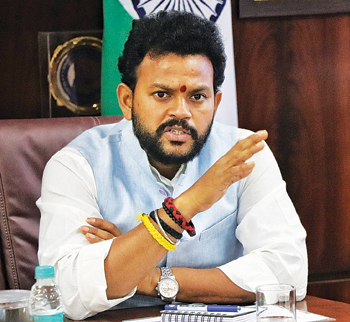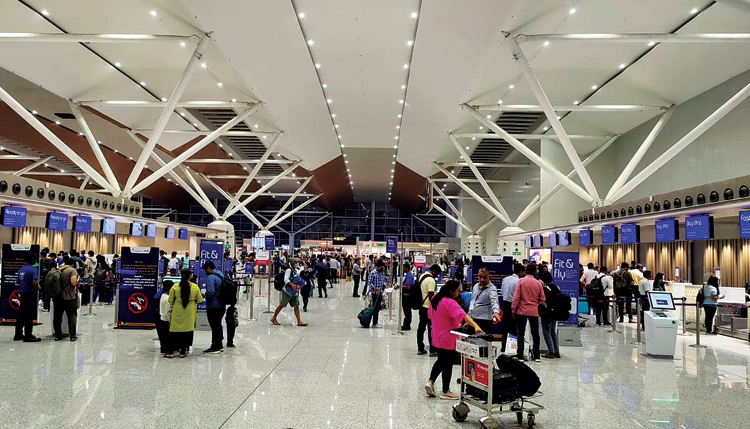INDIAN ARMED FORCES CHIEFS ON OUR RELENTLESS AND FOCUSED PUBLISHING EFFORTS

The insightful articles, inspiring narrations and analytical perspectives presented by the Editorial Team, establish an alluring connect with the reader. My compliments and best wishes to SP Guide Publications.

"Over the past 60 years, the growth of SP Guide Publications has mirrored the rising stature of Indian Navy. Its well-researched and informative magazines on Defence and Aerospace sector have served to shape an educated opinion of our military personnel, policy makers and the public alike. I wish SP's Publication team continued success, fair winds and following seas in all future endeavour!"

Since, its inception in 1964, SP Guide Publications has consistently demonstrated commitment to high-quality journalism in the aerospace and defence sectors, earning a well-deserved reputation as Asia's largest media house in this domain. I wish SP Guide Publications continued success in its pursuit of excellence.
New Leadership to Chart the Course
The new Civil Aviation Minister will need to rise to the challenges and fulfill the demands of India’s thriving aviation sector

Amongst the roar of jet engines echoes across India and passenger traffic on a record-breaking climb, India recently witnessed the return of Modi 3.0 governance with the reins of the booming Indian aviation sector switching to one of the youngest ministers in Modi cabinet – 36-year-old, Kinjarapu Rammohan Naidu, India’s new Civil Aviation Minister. Experts believe he has a host of challenges as the new minister of civil aviation and will need to rise to the challenges of the industry.
COMMERCIAL AVIATION: A PHOENIX RISING
“India’s new Civil Aviation Minister enters the ministry at an opportune time,” says Prakash Babu Devara, Director of Product Marketing at Cognitus. “The industry outlook is quite positive,” he adds, “but there are significant challenges that need to be navigated to sustain growth.”
India has one of the largest aircraft orders globally—1,150 aircraft by 2035—but the country’s infrastructure must be robust enough to handle the increased aircraft and passenger demand. Developing a sound aviation ecosystem is one of the biggest challenges facing the new minister. Additionally, there’s a pressing demand from Middle Eastern carriers for more bilateral flying rights. “Considering this boom, we hope the new minister will address the ongoing demand from the UAE and Qatar for more bilateral flying rights,” says Jaideep Mirchandani, Chairman of SkyOne. “We seek a balanced approach that promotes fair competition and growth for all stakeholders.”
BUSINESS AVIATION: A GLITTERING FUTURE
While commercial aviation caters to the masses, business aviation offers a bespoke experience for the chosen few. CEOs with packed schedules and executives juggling multi-million dollar deals find solace in the time-saving magic of private jets. “Business aviation isn’t just a luxury,” says Sadaf Herekar, Executive Director of Plexus Aviation. “It’s an indispensable tool for economic leaders, a crucial driver of India’s growth.” It’s a sentiment echoed by industry veterans. Atiesh Mishra, Founder and Director of AJM Jet Management, paints a picture with statistics: “From a marginal 1-2 per cent growth in business jet fleets between 2010 and 2021, we’ve seen a surge to 10-12 per cent since 2022. Our fleet size currently stands at 164 jets, and it’s only going up.”

THE REINS OF THE BOOMING INDIAN AVIATION SECTOR HAVE BEEN HANDED OVER TO KINJARAPU RAMMOHAN NAIDU
The recent “wedding of the century” - the Ambani extravaganza - served as a microcosm of India’s booming business aviation scene. Reports suggest Mukesh Ambani arranged a fleet of 100 planes, including 3 Falcon 2000 jets from Club One Air, to ferry elite guests across the country. Now with the upcoming Vidhan Sabha elections across various states in India, time could not have been more right for the new minister of civil aviation to take charge and address the concerns of business aviation fraternity.
This kind of demand, however, exposes the sector’s soft underbelly – a system riddled with red tape. “Government policies and regulations primarily focus on the mass market and scheduled airlines,” explains Arun Kashyap, Founder and Promoter of newly launched Sirius Aviation. “The private business jet segment, despite thriving on the demand from high-networth individuals and corporate leaders, faces an uphill battle.”
A CHORUS OF DEMANDS: STREAMLINING THE SKIES
The industry has a clear message for the new Minister of Civil Aviation: streamline the processes! Experts like Herekar urge the implementation of tax incentives and a reduction in duties on aircraft imports and maintenance. “This would make operating and maintaining private charters in India more financially viable,” she argues. Mishra echoes the sentiment, advocating for a reduction in GST applicable to business aircraft charters to create a level playing field with international operators. The approval and licensing process is another major bottleneck. “It can take days, sometimes weeks, even months,” sighs Herekar. “This creates frustration for both private charter companies and their clients.” Simplifying and expediting these processes, along with providing clear and consistent regulations, is at the top of the industry’s wishlist. Interestingly Rajan Mehra, Chief Executive, Club One Air expects the minister to look into a matter that’s not entirely in his control. “If the new minister can put enough pressure on the Oil minister, Finance minister and States (because the States are a stakeholder) to bring fuel under GST, that would be his biggest achievement.”
Lovejeet Singh, Partner, Corporate & Aviation at Chandhiok & Mahajan has urged the minister to consider full implementation of Cape Town Convention. Although October 3, 2023 notification was issued to give comfort to lessors when it comes to re-possession and it has also been tested in Go Air case by the Delhi High Court, the lessors still want to see full implementation of Cape Town Convention. Singh also wants the new MoCA to speed up the implementation of fractional ownership policy. “The draft guidelines were issued a while back but the DGCA is yet to issue the final version,” Singh says. “The implementation of fractional ownership policy will be a boom for the private aviation,” Singh further adds. Supporting Singh’s statement Herekar also feels that the government should encourage ownership of aircraft and streamline management and operations.
Kashyap’s expectations are in the form of four-point plan for the ministry. They are:
- Increased Slot Availability: Ensuring a minimum of five slots per hour during peak traffic times would enhance operational flexibility.
- Streamlined Clearances: Implementing single-window time-bound clearances for nonscheduled permit services at the Directorate General of Civil Aviation (DGCA) and the Airport Authority of India (AAI) would expedite processes.
- Addressing Monopolistic Practices: Removing monopolistic practices at airports (such as Ground Handling Agencies and maintenance agencies) would promote fair competition.
- Alignment with International Standards: Streamlining policies in line with the European Union Aviation Safety Agency (EASA) and the Federal Aviation Administration (FAA) rules would enhance efficiency and safety.
Looking at the above four-points Kashyap feels that implementing thoughtful policy changes can further boost this sector and contribute to India’s emergence as a global leader in aviation. Summing up the policy reforms, Herekar states that the Minister should focus on policies that encourage the growth of the private charter sector, such as subsidies or grants for new operators and startups.
INFRASTRUCTURE FOR GROWTH
Business aviation isn’t just about luxury travel; it’s a pillar of economic development. “This sector can actively promote economic activity and generate employment,” emphasises Mehra. Dedicated infrastructure, including exclusive terminals, hangars, and parking spaces at major airports, is a pressing need. Herekar emphasises the importance of promoting private charters not just as a luxury but as a viable and efficient mode of transport for business and leisure, attracting both domestic and international clientele.
Mehra goes a step further, “The current focus seems to be on large cities,” he observes. “Small business jets often need to access remote towns where industrialists are setting up plants. Tier II and Tier III airports, even some remote locations, deserve the same priority as larger hubs.” Herekar echoes this sentiment, highlighting the need for enhanced regional airport infrastructure to support private charter operations in underserved and remote areas, ultimately promoting better connectivity and economic development in those regions.
“Anything can happen in business aviation,” Mehra continues, his voice filled with a hint of excitement. “A business leader traveling on a small plane could end up launching a large industry in a small town, leading to a huge employment generation and a ripple effect on further infrastructure development in terms of roads, hotels, shopping malls, etc.”
AIRPORT DEVELOPMENT
Developing more Indian hubs like Dubai is another major issue. Funding for expansion at private airports remains a concern. Mirchandani hopes the ministry will prioritise developing Indian hubs to rival those in Dubai and Doha. “This includes securing funding for airport expansions and solving resource shortages, such as pilots, engineers, and air traffic controllers, to support rapid growth,” he says.

“The Minister needs to focus on facilitating the growth of civil aviation to realise the ambitious plans of increasing the number of airports and introducing hundreds of new air routes,” says Subir Hazra, Chief Commercial and Strategy Officer at GMR Services, GMR Group. “MoCA should design policies and take initiatives to develop major Indian airports as global transit hubs to boost international traffic, rival the world’s premier aviation hubs, and increase operational efficiency,” Hazra echoes Mirchandani’s thoughts. He outlines the following priorities for the new minister:
- Full support for airport operators to modernise and extend non-aeronautical services.
- Prioritising airport land development to compete with world-class standards, benefiting both the aviation industry and the nation’s overall economic development.
Additionally, the government’s plan to lease out 13 airports to private players has been on hold for four years. Mirchandani hopes the ministry will expedite this plan. “We hope the revival will be quick, as it is crucial for modernising our aviation infrastructure and enhancing operational efficiency,” he says.
Arvind Chandrashekhar of Lufthansa Consulting sums it up: “Reinvigorating asset development and capacity expansion, including reinitiating stalled airport privatisation, are key areas the new minister needs to focus on.”
TAKING FLIGHT WITH TECHNOLOGY
The digital revolution hasn’t spared the aviation industry, and India needs to embrace it wholeheartedly. Herekar laments the fact that many Indian airports still lack basic amenities like automation in booking and ground handling. Upgrading air traffic management systems (ATMs) to next-generation technologies like satellite-based navigation (SBN) will be crucial for streamlining operations and ensuring efficiency. Advanced technologies like artificial intelligence (AI) can be harnessed to optimise flight paths, predict maintenance needs, and personalise passenger experiences in business aviation. Machine learning algorithms can help streamline operations and improve safety across the board.
Investment in digital infrastructure, from cloud computing to robust cybersecurity measures, is essential. Ritesh Agarwal, CEO of a leading aviation technology company, emphasises, “Embracing automation in areas like air traffic management and baggage handling will be key to enhancing efficiency and reducing costs.” This will not only benefit business aviation but also the commercial sector, creating a more seamless travel experience for all.
THE UNTAPPED POTENTIAL OF HELICOPTERS
Helicopters, the workhorses of the skies, often get sidelined in the conversation about business aviation. However, Captain Peeush Kumar, Executive Pilot at Chipsan Aviation Private Limited, believes their time is nigh. “The government and stakeholders are finally realising the importance of helicopters, not just for transportation but for overall business and economic growth,” he asserts.
Kumar identifies several areas where the MoCA can unlock the true potential of helicopters in India. First, he calls for an electronic platform at the DGCA and AAI that allows operators to address concerns about process delays, application rejections, and outdated regulations. “Currently, the system lacks accountability and transparency,” he explains. “There’s no forum to raise these issues, leading to unnecessary costs and delays for both operators and personnel.” Audits at DGCA and AAI, with a focus on scrutinising timelines and rejected applications, are another recommendation Kumar makes.

The RCS-UDAN scheme, aimed at promoting regional connectivity, has been lauded for its vision. However, Kumar argues that it hasn’t fully embraced the potential of helicopters. “Sub-400 km sectors under RCS-UDAN have a low sustainability rate,” he points out. “This distance is perfectly suited for helicopter operations. Enabling technology is already available at Indian airports, but helipads remain neglected. This is a missed opportunity.” Kumar proposes a comprehensive deployment of helicopters under the RCS-UDAN scheme, utilising Performance Based Navigation (PBN) based operations for all-weather, day-night connectivity, ultimately strengthening the scheme’s regional reach.
Finally, Kumar urges the AAI to establish a dedicated section or directorate for helicopter growth, similar to what exists for the DGCA. “This would demonstrate a commitment to the sector and ensure accountability towards maximising its national benefits,” he concludes.
MRO ECOSYSTEM TAKES OFF
While the spotlight often shines on passenger travel, a crucial yet less-discussed aspect of aviation is Maintenance, Repair, and Overhaul (MRO). “A robust MRO sector is the backbone of a thriving aviation industry,” explains Anand Kumar, CEO of SkyTech MRO. “It ensures the airworthiness of aircraft, minimises downtime, and keeps them flying safely and efficiently.” However, the Indian MRO sector faces challenges. High import duties on spare parts and a lack of skilled technicians can lead to delays and drive up maintenance costs. Experts urge the government to offer tax breaks on MRO imports and invest in skill development programs to create a pool of qualified technicians.
CARGO TAKES FLIGHT: THE UNDISPUTED WORKHORSE
The aviation industry isn’t just about transporting people; it’s the lifeblood of global trade. Cargo plays a vital role in India’s economic growth story. “The demand for air cargo has been phenomenal, especially for essential goods and pharmaceuticals during the pandemic,” says Mihir Thadhani, Head of Cargo Sales at a leading Indian airline. “E-commerce is also a major driver, and we expect this growth to continue.” Experts believe that streamlining customs clearance processes and developing dedicated cargo terminals at major airports will further boost India’s cargo handling capabilities.
SKILLING A WORKFORCE FOR THE FUTURE
A skilled workforce is the fuel that propels the aviation industry forward. “The current education and training infrastructure needs a significant upgrade,” says Captain Rohit Prakash, Director of Training at a leading Indian flight school. “We need more government-supported training programs and industry collaboration to bridge the gap between theoretical knowledge and practical skills required for various aviation roles, from pilots and engineers to air traffic controllers and ground handling staff.”
FINANCIAL TURBULENCE AND TAILWINDS
The Indian aviation sector has weathered the storm of the pandemic and is now experiencing a period of financial recovery. However, challenges remain. “Fuel price fluctuations and currency volatility continue to exert pressure on airline profitability,” says Shashank Sharma, a leading aviation analyst. “Airlines need to adopt innovative cost-cutting measures and explore fuel hedging strategies to mitigate these risks.” The growth of the low-cost carrier (LCC) segment is a positive indicator, offering passengers greater affordability and airlines improved load factors. Industry experts believe that a stable regulatory environment and access to affordable financing will be crucial for sustained financial growth in the sector.
A COLLABORATIVE TAKE-OFF
India’s new Civil Aviation Minister steps into office at a pivotal moment. The aviation industry is experiencing significant growth, bolstered by the nation’s extraordinary economic progress and increasing global influence. Also, studies forecast a substantial rise in the number of millionaires in India, leading to a surge in investable wealth. This positive outlook is tempered by challenges that require strategic management to maintain momentum.
Given this landscape, the new minister’s role is critical. Expectations are high for fostering a supportive environment for the commercial aviation and private charter sectors. This includes ensuring regulatory ease, providing infrastructural support, and implementing policy initiatives that drive growth and development. With a shared vision and a commitment to excellence, India’s skies can become a canvas for a thriving aviation ecosystem, connecting people, businesses, and ideas like never before.





